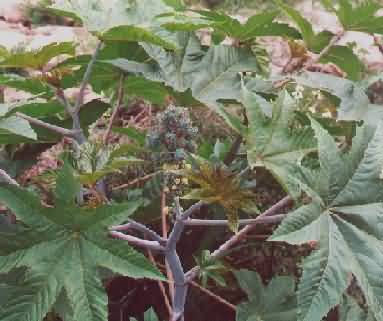अरंड की खेती कैसे करें
Castor (Ricinus communis L.) is generally grown for seeds. Castor seed oil is being used widely for various purposes. It is used as a lubricant in high-speed engines and aeroplanes, in the manufacture of soaps, transparent paper, printing-inks, varnishes, linoleum and plasticizers. It is also used for medicinal and lighting purposes. The cake is used as a manure and plant stalks as fuel or as thatching material or for preparing paper-pulp. In the silk-producing areas, leaves are fed to the silkworms.
How to grow Castor
Land prepration for castor cultivation:
The land is repeatedly ploughed in summer, as and when the rains are received, and with the onset of monsoon rains the clods are crushed by working a country plough or harrow to bring the soil into proper tilth.
Sowing of castor:
Before sowing, castor seed should be treated with Thiram 3 g/kg of seed to prevent the attack of root-rot and Alternaria blight. The spacing adopted generally ranges from 90-120 cm between rows and 45-60 cm between plants in the row.
The seed is sown either in the plough furrow or with a seed-drill or by hand-dibbling. The seed-rate used for sowing behind the plough is 12 kg per hectare. For hand-dibbling, 8 to 10 kg of seed will be sufficient per hectare.
One or two weedings and hoeings with bullock-drawn implements are given and sometimes, the plants are earthed up.
Varieties of castor:
The varieties of castor differ in the branching habits of plant, colour of the stem and branches (red and green), the nature of capsules (smooth or shiny), duration (early or late) and the size of seed.
Some of the high yielding castor varieties are NPH-1 (Aruna), GAUCH-4, and TMVCH.
Newly released castor hybrid recommended for cultivation in Tamil Nadu is TMVCH by Oilseeds Research Station of the Tamil Nadu Agricultural University (TNAU) Tindivanam. This hybrid matures in 160-170 days. Its seeds contain 51.7% oil. It is moderately susceptible to semilooper pest and moderately resistant to wilt and grey mould.
Fertilizer application in castor:
The fertilizer dose recommended for castor is 40 N-40 P-20 K kg/ha. The entire dose of P and K and half of W is applied basally and the remaining half of W about 30 days after sowing, as and when the soil moisture is adequate.
Harvesting:
The improved varieties maturs in about 150 to 180 days. When one or two capsules in a bunch show signs of drying, the whole cluster is generally removed and stacked, covered and weighed in a corner of the field or in a pit. The harvesting of unripe capsules in this manner has an adverse effect on the oil content of the seed and hence should be avoided. It is preferable to collect the fruits, as and when they ripen.
When the whole crop is gathered, it is dried in the sun for a few days and the threshiug is done either by beating the dried capsules with a stick or by treading them under the feet of bullocks. Winnowing is done in the usual manner.
Yield:
The average yield of rainfed castor ranges from 200 to 500 kg per hectare and that of the mixed crop from 100 to 200 kg/ha. In irrigated Area the castor crop yieds 500 to 800 kg/ha.
PESTS AND DESEASES OF CASTOR CROP:
The castor semi-looper and the capsule-borer are the two most serious pests of castor. Dusting BHC 10% in early stages or spraying 0.1% Carbaryl on the crop will give an effective control on these pests.
The seedling blight and Alternaria blight cause serious losses to this crop. The Sowing of the crop in low-lying and water-logged areas should be avoided to prevent the seedling blight from appearing. For alternaria blight, seed treatment with Thiram at the rate of 3 g/kg of seed is recommended.
Source: IARI information bulletin

